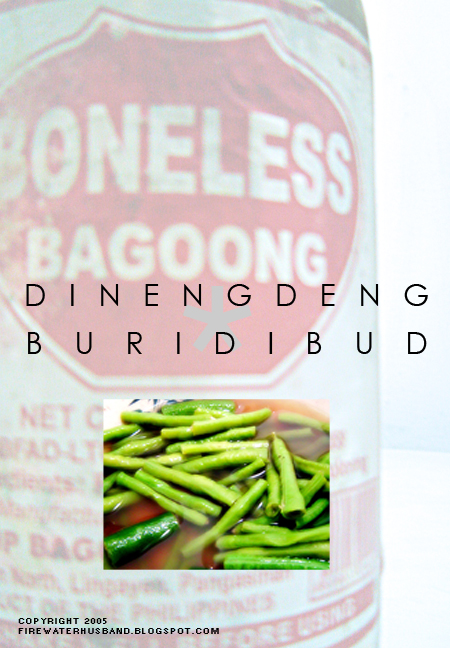
"Modern technology...allows me to guarantee the exact time and temperature for cooking the dishes. That's progress. But when it means banalizing the taste of products, that's a step back, and, cook that I am, I rebel."
--Alain Ducasse
Like clothes to a man, it's not the grilled fish, honey, that makes a dinengdeng. The lifeblood of this broth is bagoong Pangasinan, which should not be confused with bagoong alamang. The former is composed of fermented fish while the latter is fermented shrimp. Our bagoong comes from Pangapisan North in Lingayen, but even if we buy them boneless and by the dozen, it's become a habit to strain the broth for the occasional wayward scale or a stray sludge particle.
I still have to make a hard and fast rule on what vegetables can be included in a dinengdeng. No carrots, cabbage, broccoli or anything "Western" but I've tasted one with oyster mushrooms and everything went well. No aromatics for sure, like onion, garlic and leeks. I can't say use natives or go Oriental because kangkong and pechay are not in the list. Probably anything that can spell "harsh" like the texture of burlap--okra, ampalaya and sitao. But then again add the sweetness of camote and the dish transforms into Buridibud. For eastern Tagalogs bordering Ilocandia meanwhile, adding horseradish (hagod) is already treading into Bulanglang territory.
Just add whatever vegetable you fancy, but bear in mind that dinengdeng is a state of mind. These greens should marry the bagoong willingly to produce an Ilocano umami the way they do with pinakbet. Sipping a tablespoon is an aquired taste, but after the first slurp, there's no looking back.
To a cup of boiling water, add a tablespoon or two of bagoong Pangasinan and simmer for a while, about five minutes. Strain and put the broth back into the pot. Add two or more of the following vegetables:
a cup of sitao cut into 2-inch lengths,
a cup of okra,
a bunch of camote tops,
a bunch of saluyot leaves,
a cup of chopped and seeded ampalaya fruit,
a bunch of ampalaya leaves,
a cup of sliced eggplants,
a bunch of ar-arosep,
a cup of peeled horseradish (hagod),
a cup of malunggay leaves,
a cup of chopped cigarillas,
a cup of cubed camote,
a cup of banana blossoms,
a cup of bamboo shoots,
a handful of flor de carrabaza (squash flowers),
a bunch of carrabaza tops
and many more.
When the vegetables are cooked but firm, adjust the taste and add more water if necessary. The dinengdeng can be served as it is or topped with grilled fish, leftover or otherwise. For a sour variation, which is usually done over banana blossoms and saluyot, add tamarind powder or dried kamias (see preceding post). Serve warm with rice.


3 Comments:
just found your blog -- wow! it's exciting to see another pinoy food blogger. hope you'll join us for lasang pinoy sometime. details here:
http://www.stefoodie.net/index.php?page_id=293
stef, i'd sure love to. will post one soon. thanks for the link!
Ooooh, i like your blog. I like everything that pertains to food.
I'm a novice cook so I am more into eating than cooking but I like looking at your pics.
Check me out too at
theblairmitchchronicles.blogspot.com
Post a Comment
<< Home